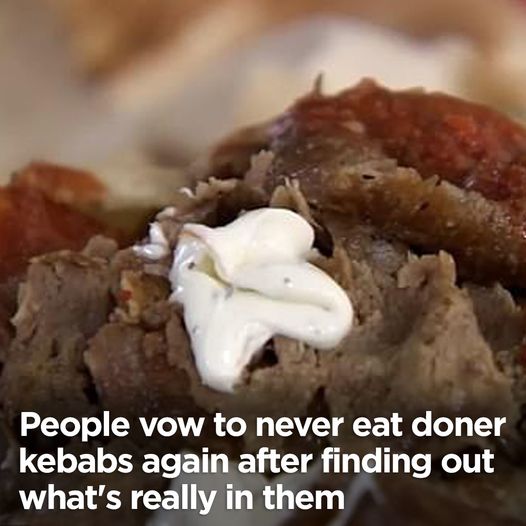For many partygoers, a kebab on the way home has become essential to their night out. However, a revelation about the production process behind this popular takeaway has left some feeling ‘disgusted.’ Together TV shared The eye-opening footage on YouTube from Channel 4’s Food Unwrapped. In this exciting episode, the show delves deep into the mysteries, secrets, and myths surrounding various foods worldwide.
Specifically, the focus was on doner kebabs, a delicious Turkish delicacy made from minced meat stacked in the shape of an inverted cone and cooked on a vertical rotisserie. The video pulls back the curtain, showing precisely what ingredients and methods are used to create this fast food favorite.
The iconic late-night doner kebab, a favorite among many, has always piqued curiosity about its mysterious meat content. Finally, the secrets have been exposed.

In the video, the presenter, Jimmy Doherty, stands outside a kebab and burger eatery, examining a freshly served doner kebab. He remarks on the difficulty of identifying the meat, which appears as mere shavings. Taking a bite, he describes it as somewhat bready, but the true nature remains elusive.
Determined to uncover the truth, Doherty contacts a kebab shop owner, asking about the kebab’s meat. The owner confirms that if bought from him, it indeed contains lamb. However, the owner admits being unsure when asked about kebabs from other sources.
Not content with vague answers, Doherty visits Veli’s Kebabs factory in Staffordshire, England, a supplier responsible for a huge 50 tonnes of doner kebab meat per week, distributed to shops across the UK. Inside the factory, he is shown a room filled with the original form of kebab meat. Reading the writing on one box, Doherty confidently identifies it as lamb trim, shedding light on the composition of this beloved late-night snack.
As the unnamed factory worker guided him through the process, startling revelations came to light. He explained that the meat used in their kebabs comes from trimmings discarded by big supermarkets. These trimmings are collected, minced, and then mixed with other ingredients.

The kebab meat is made of 85% lamb, which is the part labeled as “doner” and associated with the traditional spit-roasted kebabs.
To keep costs down, 5% of the mixture is made up of textured soya protein, serving as a bulking agent. Additionally, 5% is rusk, and the remaining 5% consists of seasoning and salt. The salt is needed for emulsification, which prevents the kebab from flaking and allows it to be cut into neat, straight strips.
The processed mixture is then molded into thick discs that are stacked on a spit. Between each disc, lamb skin is added, playing a crucial role in binding the entire kebab together. The worker also showed concern that some companies may mislabel their kebabs, adding ingredients like beef, chicken, and even pork, which is strictly prohibited by those of the Muslim faith.
This behind-the-scenes look at the production process has left some feeling uneasy about what goes into their beloved kebabs

The viewers’ reactions to the behind-the-scenes look at the kebab production process are varied and reflect a range of sentiments.
Some individuals were left feeling disgusted and repulsed by the discovery. They expressed disappointment that the modern-day doner kebabs taste different from how they remembered in the past, suggesting that cost-cutting measures have led to a decline in quality.
On the other hand, some viewers seemed indifferent about the production process, attributing the popularity of kebabs to the fact that they are often eaten when people are drunk after a night out. They acknowledged that while there might be questionable elements involved, the taste is what matters to them, and they have no plans to stop eating kebabs. In many ways, kabab meat is similar to other processed meats like some sausages and American hot dogs.

There were also comments from viewers who rejected or downplayed the information presented in the video. They stated that when intoxicated, people don’t care about what’s in their kebab, and the taste is all that matters. One user even joked about kebabs being made out of leftover meats but still tasting good.
Another viewer expressed concern for the Muslim community, as kebabs are often consumed by Muslims who may not be drunk, given the prohibition on alcohol in their faith. They questioned the halal status of kebabs and felt that they are more suitable for drunk individuals than sober ones.

In summary, the viewers’ responses range from disgust and disappointment to indifference and enjoyment, with some raising concerns about the ingredients, halal status, and context in which kebabs are typically consumed.
